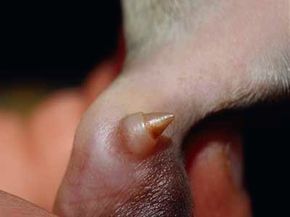The duckbill platypus has been called a lot of things since it arrived on the zoological scene in 1798. One adjective that's likely never been applied to the mammal is "normal" -- after all, its physiology and anatomy borrow from birds, reptiles and mammals in a baffling conglomeration of webbed feet and a duck bill, the ability to lay eggs (familiar to both birds and reptiles) and a furry body. In fact, experts in England laughed off the first specimen brought over from its native Australia, believing it was a poorly constructed hoax, like the Bigfoot creature that two supposedly found in north Georgia in the summer of 2008.
It's common knowledge that the platypus is a definite oddball in the animal kingdom, but what characteristics really puzzle scientists? Because the platypus has fur and the female nurses its young, the animal is classified as a mammal. But that's where the mammalian similarities stop. The female platypus doesn't nurse with nipples; instead, she secretes milk into her abdominal skin that the babies, called puggles, suckle on. They also have webbed feet and bills like birds and lay eggs like reptiles. Also like birds, platypuses have only one orifice for excretion and birth, which is why they're called monotremes, along with echidnas.
Advertisement
The platypus even shares a special sensory capability with the shark. You see, the platypus lives in and around rivers and feeds off of insects, larvae, shellfish and worms, which it locates underwater. Because it closes its eyes and seals off its nostrils upon submersion, scientists wondered how it manages to hunt without the help of sight or smell. It turns out that tiny pores called electroreceptors dot the platypus bill. These pores open up into sensitive nerve endings that can detect changes in the electrical current in the water. That electricity exists in the form of muscle movements and sometimes from water rushing over stationary objects. This "sense," termed electroreception, is the same method sharks use to hunt. (A detailed explanation of electroreception can be found in What is electroreception and how do sharks use it?
But the surprises in this anatomical funhouse don't stop there since we have yet to discover a reptilian connection that has something to do with platypus poison.
Advertisement




